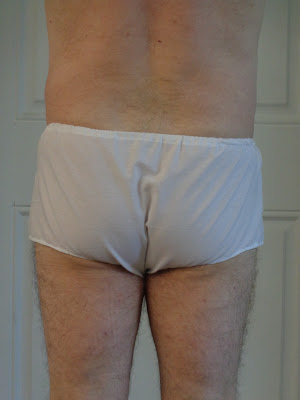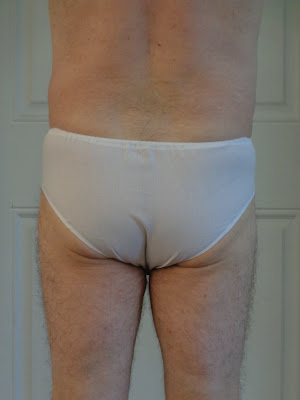Some of the earliest work on this campaign of underwear research was on the legless TypeV. At the time, I presumed that all TypVs were legless, but I have reconsidered that in light of the TypeIV. It seems like my category TypeV may include two different constructions, and thus is not a true type. This must lead to a restructuring of the system.... but not today.
The legless Type Vs I worked on at the beginning of September are based on this layout. Obviously, one could work with smaller pieces of fabric by making there be a seam across the crotch, but that will be left as an exercise for the tailor.


In art, this type is characterized by the sweep of diagonal wrinkles the define the upper corners of the package. This contrasts with the "U" shape of the ones I showed above.

I only made one pair in this series, but I clearly need to return to it and tighten up the sides a bit. Making the crotch a bit wider might not be a bad idea as well. That would make the pouch a bit more generous.



The thing that strikes me about these braies is that they are extremely simple to pattern and make. They are comfortable, and the leg movement is very free. If you are doing the mid to late 15th C, you pretty much can't go wrong with these.
Here are some more examples from art.



This brings us to the more abbreviated variant of the legless Type V.
In art, these have an teardrop shaped package whose upper end is strongly pursed by the drawstring. The tension of the pursing leads to diagonal wrinkles which lead from the knot, downward toward the hips.

My first attempt was a made by simply removing material from the hips of the template I showed above.

The drawstring crosses itself in the front of the casing, as usual, but the ends emerge farther apart. This produces the pursing as well as drawing the garment tighter around the hips. This example shows very well how the drawstring crosses, as well as showing what the braies look like untied.

Me first attempt worked OK. Again, a slightly wider crotch would be an improvement. I might also add a bit of width to the lower butt so as to not show so much gluteal fold.



While this first attempt worked OK, I still did not get the sort of brevity and package isolation we see in some art.




...so, I tried again with even less fabric.



Now, we're getting somewhere! When making these "extreme" legless Type Vs, I found that difference between the stretch of the fabric along vs. across the grain made a difference. My muslin stretches a bit more across the grain, so that had to be the horizontal direction. This probably means that I have them too tight at the sides, and should get rid of "straight up and down" side seams in favor of something that is a bit wider at the leg than the hip... and perhaps a bit wider all around.
The pattern looks much like the previous one.

I should make at least one test with the grain on the bias and see how that works. Or, perhaps someone else would like to try that and tell us how it goes.
Mac






























